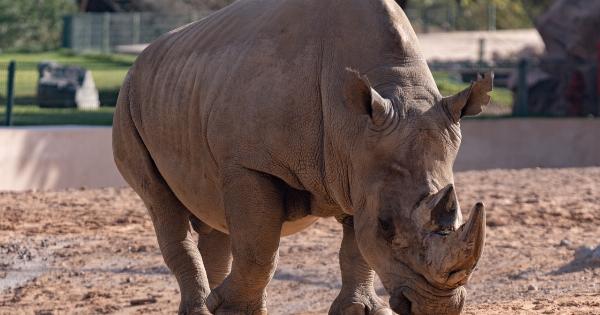If you’re new to learning about rhinos, you might be wondering where to start. Rhinos are fascinating creatures that belong to the family Rhinocerotidae. They are also known as rhinoceroses or simply rhinos.
There are five rhino species in the world, each with their unique characteristics, behavior, and habitat. In this beginner’s guide, we will go over the basics of rhinos, their habitat, behavior, conservation efforts, and more.
The Five Rhino Species
As mentioned earlier, there are five rhino species in the world. They are:.
- African White Rhino
- African Black Rhino
- Indian Rhino
- Sumatran Rhino
- Javan Rhino
Each species has distinct characteristics, behavior, and habitat. The African White Rhino, for example, can weigh up to 2,300 kg (5,000 lb) and is the largest rhino species.
On the other hand, the Sumatran Rhino is the smallest and can weigh up to 900 kg (2,000 lb). It is essential to understand the characteristics of each species to gain a better understanding of rhinos as a whole.
Rhino Habitat
Rhinos can be found in different habitats, depending on the species. African Black Rhinos, for example, can be found in savannahs, grasslands, forests, and shrublands. Indian Rhinos, on the other hand, are found in swampy and grassy regions.
Sumatran Rhinos can be found in rainforests, and Javan Rhinos can be found in rainforests and dense brush.
It is important to understand the rhino’s habitat because it helps conservationists protect their natural environment. Deforestation, urbanization, and poaching have led to a reduction in the rhino population and threaten their natural habitat.
Rhino Behavior
Rhinos can behave differently depending on the species and situation. Generally, they are solitary animals and prefer to roam alone. However, some species, such as the African White Rhino, can form groups of up to 14 individuals.
Rhinos have poor eyesight, but their sense of smell and hearing is excellent. They use their sense of smell and hearing to detect predators and locate food and water.
Rhinos are also known for their aggressive behavior, especially when threatened. They will charge at their attacker, using their horns as a weapon.
It is essential to keep this behavior in mind when encountering any rhino, whether in captivity or in the wild.
Rhino Conservation Efforts
Rhinos are endangered species, and their populations have been decreasing over the years. In the 20th century, the rhino population dropped by 90%, with poaching being one of the primary contributors.
However, there are efforts to protect rhinos and increase their population. One such effort is anti-poaching campaigns. Conservationists work to prevent poaching and trafficking of rhino horns.
Another conservation effort is habitat conservation. As mentioned earlier, rhinos have specific habitats that they live in. Deforestation, urbanization, and other human activities have disrupted their habitats.
Groups such as the World Wildlife Fund and the International Rhino Foundation work to protect and restore the rhino’s natural habitat.
Rhino Breeding Programs
Conservationists also run breeding programs to increase the rhino population. These programs involve pairing rhinos, sometimes across different species, to breed and produce offspring.
The offspring is then released into the wild or into protected areas to increase their population. However, breeding programs face challenges such as inbreeding depression, genetic disease, and habitat loss.
Rhinos are essential to the ecosystem, and their role in maintaining the balance cannot be understated.
Conservation efforts are essential to protect these magnificent creatures, and everyone can play a part in protecting them by spreading awareness, reducing demand for rhino horns, and supporting conservation programs.
Rhinos in Culture
Rhinos have a place in different cultures around the world. In African cultures, rhinos are revered for their strength and ferocity and are often depicted in African art and sculptures.
In some cultures, rhino horns are believed to have medicinal properties, leading to their poaching and trafficking. In Western cultures, rhinos are often depicted in popular media, such as movies and books.
Conclusion
Rhinos are fascinating creatures with unique characteristics, behavior, and habitats. There is still so much to learn about these creatures, and their protection remains vital in maintaining the balance of the ecosystem.
By understanding rhinos and their challenges, we can play our part in protecting them.































